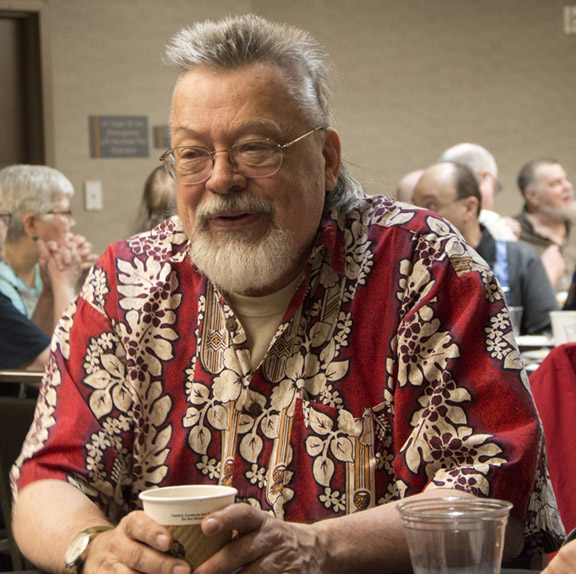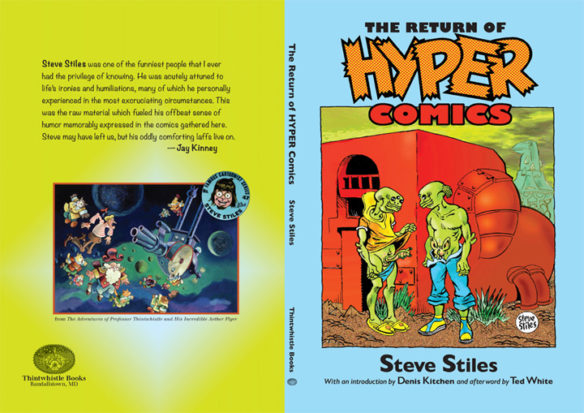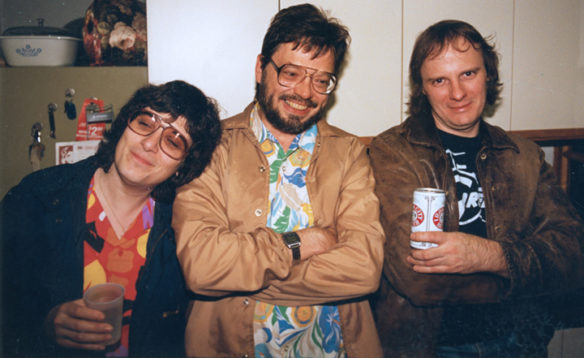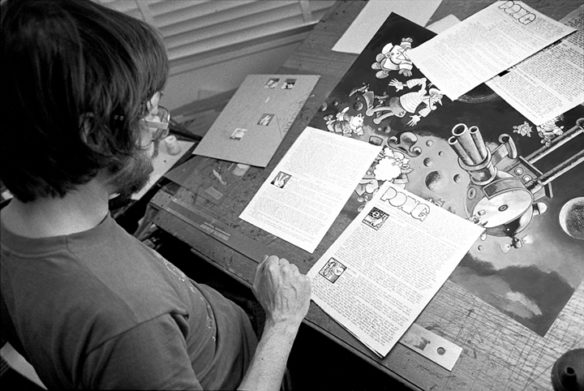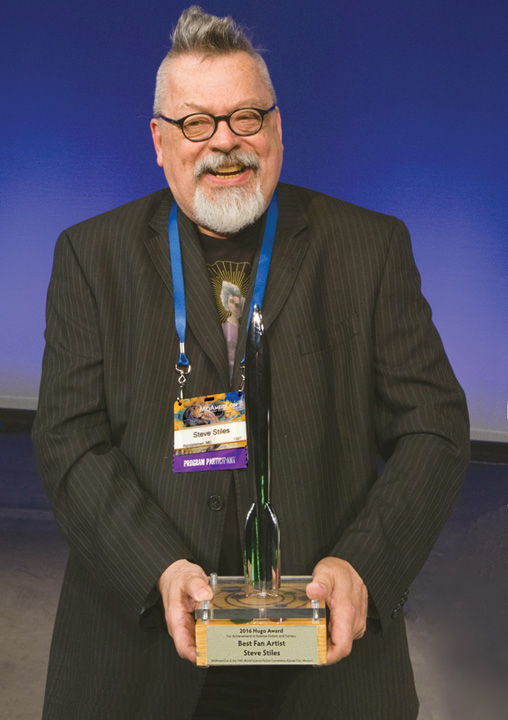(1) CHENGDU’S OFFER TO HUGO FINALISTS. Joe Yao, a WSFS Division department head for Chengdu, provides more information about the assistance being offered to 2023 Hugo finalists to attend the Worldcon:
As it is the first time a Worldcon held in China, along with the first time for the Hugo Awards presented in China, we really like to have more finalists coming in person, and they can also participate in program and other activities if they want. But as we all know, it is a long and expensive trip for most of the finalists and they might not afford such a trip by themselves, thus we tried our best to help them, even though we have limited budget as well.
Hope there will be more finalists coming in October.
It appears the offer of help is being offered to 2023 Hugo finalists generally (or to one representative of finalists involving teams of multiple editors/creators). A few more people who have confirmed to File 770 that they received the offer include Gideon Marcus, Alison Scott, and Olav Rokne and Amanda Wakaruk (the latter got theirs today; they didn’t have it yet when they responded yesterday.)
(2) WRITER BEWARE. “Contract, Payment Delays at the Magazine of Fantasy and Science Fiction” at Writer Beware.
F&SF takes First North American Serial Rights and pays on acceptance (which in practice means on receipt of a contract). Acceptance emails indicate that writers will receive a contract and a check within two to four weeks. However, Writer Beware has recently received multiple reports from writers whose work has been officially accepted but, months later, are still waiting for contracts and checks.
…Writers also report a variety of other delays: waiting for notification of official acceptance well beyond the stated acquisition timeline of 6 weeks to 6 months; receiving copy edits and proofs for accepted stories without having received a contract or payment; receiving contract and payment only weeks before the publication date, after months of waiting; completing requested revisions and then hearing nothing more. Many of the writers who contacted me say that they’ve sent repeated emails asking about the delays, and haven’t received a response….
Writer Beware’s Victoria Strauss contacted F&SF publisher Gordon Van Gelder and heard what he is doing to resolve the issues. See his responses at the link.
(3) SDCC AMID THE STRIKES. Rob Kutner says the lack of big movie presentations had its advantages in “Comic-Con In the Time of Strikes” at Book and Film Globe.
…As I’ve written here, Comic-Con offers many uses for the working (on non-struck things) professional. I came this year in part to network for gigs, and in part to sign my new kids’ graphic novel at my publisher’s table. Neither of those directly tied to the big panel/preview scene, so for me it was mostly business as usual. Nor, at first glance, could I necessarily spot a difference, other than some occasionally empty patches in the crowds, which would normally be wall-to-wall nerd.
However, after two days, some patterns began to emerge, and friends and colleagues that I spoke to confirmed this. As Craig Miller, Lucasfilm’s Director of Fan Relations for the first two Star Wars movies, described it, the effect on strike-year Comic-Con was “both profound and minimal. Hall H, the big, 6,000-person room”—where they often announce the latest Marvel or Star War for the first time — “is empty. There are no lines of people waiting hours to get into that room. But they’re still here at the convention.”
As a result, Miller spent the Con at a table, selling his memoir Star Wars Memories, and sold every last copy. Granted, any SDCC might have brought him scads of customers who liked both Star Wars and books, but it’s also a highly competitive environment, with literally hundreds of vendors and publishers vying for those same dollars.
This time, however, the diversion of crowds, who might otherwise be in Lineworld, onto the main convention floor created a flood of foot traffic for vendors that lifted even the smallest boats. Rantz Hoseley, VP of Editorial for Z2 Comics, confirms, “sales and signings at our booth were the biggest we’ve had at any convention, with a number of deluxe editions selling out by Thursday evening [the first of Comic-Con’s four days].”…
(4) BACK TO 1955. In “Buckle Your (DeLorean) Seatbelt: ‘Back to the Future’ Lands on Broadway”, the New York Times talks to franchise co-creator Bob Gale.
…And now on Broadway: “Back to the Future: The Musical,” which opens Aug. 3 at the Winter Garden Theater, follows a story that will be familiar to fans of the film. Using a time machine devised by Doc Brown, Marty McFly travels to 1955, meets his parents Lorraine and George as teenagers and must help them fall in love after he disrupts the events that led to their romantic coupling.
On its yearslong path to Broadway, “Back to the Future” has faced some challenges that are common to musical adaptations and others unique to this property.
While the show’s creators sought actors to play the roles indelibly associated with the stars of the film and decided which of the movie’s famous scenes merited musical numbers, they were also trying to figure out how the stage could accommodate the fundamental elements of “Back to the Future” — like, say, a plutonium-powered sports car that can traverse the space-time continuum.
Now this “Back to the Future” arrives on Broadway with some steep expectations: After a tryout in Manchester, England, its production at the Adelphi Theater in London’s West End won the 2022 Olivier Award for best new musical. The show also carries a heavy price tag — it is being capitalized for $23.5 million, according to a filing with the Securities and Exchange Commission.
Throughout its development process, the people behind it — including several veterans of the “Back to the Future” series — tried to remain true to the spirit of the films and keep intact a story that has held up for nearly 40 years.
Bob Gale, who wrote the original movie with Robert Zemeckis, said of the stage adaptation: “We didn’t want to reinvent the wheel. We just want to make the wheel smooth.”
But, he added, “It cannot be a slavish adaptation of the movie. Because if that’s what people want to see, they should stay home and watch the movie. Let’s use the theater for what theater can do.”…
(5) LEARNEDLEAGUE. [Item by David Goldfarb.] LearnedLeague is currently in its “off-season” when it features player-created content, including 12-question specialized quizzes that last for one day. Monday there was one about the Stargate movie and TV franchise. As I write this it’s still live, but by the time tonight’s Pixel Scroll goes out, it will be graded and so available for the public to view. Here’s a link: Stargate 1DS
(6) CORDWAINER SMITH REDISCOVERIES. James Davis Nicoll encourages readers to “Take a Minute to Celebrate the Forgotten Greats of Science Fiction” at Tor.com.
Time is nobody’s friend. Authors in particular can fall afoul of time—all it takes is a few years out of the limelight. Publishers will let their books fall out of print; readers will forget about them. Replace “years” with “decades” and authors can become very obscure indeed.
The Cordwainer Smith Rediscovery Award was founded in 2001 to draw attention to unjustly forgotten SF authors…. Since it’s been five years (and there have been four new recipients) since we last discussed the award in 2018, I’ve updated the discussion to include the newest honorees—including the most recent winner, announced this past weekend at Readercon.
I wish the award were more widely known, that it had, perhaps, its own anthology. If it did, it might look a bit like this. Who are the winners? Why should you care about them? I am so happy I pretended you asked….
(7) FANAC.ORG NEWS. The fanhistory website Fanac.org has been adding scanned fanzines at an colossal rate. Among their accomplishments, they’ve finished scanning a run of Imagination, by LASFS members during the Fighting Forties…
We’ve added more than 1,000 publications since the last newsflash in March, and about 2,000 since the last full newsletter in December 2022. We’ve added some great zines by Arnie Katz, and many APAzines from Jeanne Gomoll. Here are some highlights.
We completed our run of LASFS’s first important fanzine, Imagination including the Rejected issue. Imagination is filled with contributions from notables in the field, fan and pro, among them Yerke and Bok, Kuttner and Bloch, Bradbury and Lowndes, Hornig and Wollheim, and of course 4sj….
(8) WILL WIKI MATE WITH CHATGPT? Jon Gartner calls it h “Wikipedia’s Moment of Truth”. “Can the online encyclopedia help teach A.I. chatbots to get their facts right — without destroying itself in the process?”
…In late June, I began to experiment with a plug-in the Wikimedia Foundation had built for ChatGPT. At the time, this software tool was being tested by several dozen Wikipedia editors and foundation staff members, but it became available in mid-July on the OpenAI website for subscribers who want augmented answers to their ChatGPT queries. The effect is similar to the “retrieval” process that Jesse Dodge surmises might be required to produce accurate answers. GPT-4’s knowledge base is currently limited to data it ingested by the end of its training period, in September 2021. A Wikipedia plug-in helps the bot access information about events up to the present day. At least in theory, the tool — lines of code that direct a search for Wikipedia articles that answer a chatbot query — gives users an improved, combinatory experience: the fluency and linguistic capabilities of an A.I. chatbot, merged with the factuality and currency of Wikipedia.
One afternoon, Chris Albon, who’s in charge of machine learning at the Wikimedia Foundation, took me through a quick training session. Albon asked ChatGPT about the Titan submersible, operated by the company OceanGate, whose whereabouts during an attempt to visit the Titanic’s wreckage were still unknown. “Normally you get some response that’s like, ‘My information cutoff is from 2021,’” Albon told me. But in this case ChatGPT, recognizing that it couldn’t answer Albon’s question — What happened with OceanGate’s submersible? — directed the plug-in to search Wikipedia (and only Wikipedia) for text relating to the question. After the plug-in found the relevant Wikipedia articles, it sent them to the bot, which in turn read and summarized them, then spit out its answer. As the responses came back, hindered by only a slight delay, it was clear that using the plug-in always forced ChatGPT to append a note, with links to Wikipedia entries, saying that its information was derived from Wikipedia, which was “made by volunteers.” And this: “As a large language model, I may not have summarized Wikipedia accurately.”
But the summary about the submersible struck me as readable, well supported and current — a big improvement from a ChatGPT response that either mangled the facts or lacked real-time access to the internet. Albon told me, “It’s a way for us to sort of experiment with the idea of ‘What does it look like for Wikipedia to exist outside of the realm of the website,’ so you could actually engage in Wikipedia without actually being on Wikipedia.com.” Going forward, he said, his sense was that the plug-in would continue to be available, as it is now, to users who want to activate it but that “eventually, there’s a certain set of plug-ins that are just always on.”…
(9) MITCH THORNHILL (IRA) OBITUARY. Mitch Thornhill (Ira) died July 25 after many months of serious medical problems. He lived in Mississippi. However, he first became known as a fan in the Seventies while living in New Orleans and Minneapolis. He sometimes went by the name Ira M. Thornhill.
(10) TODAY’S BIRTHDAYS.
[Compiled by Cat Eldridge.]
- Born July 25, 1907 — Cyril Luckham. He played the White Guardian first in the Fourth Doctor story, “The Ribos Opperation”, part one, and then twice more in the two-part Fifth Doctor story, “Enlightenment”. He was also Dr. Moe in the Fifties pulp film Stranger from Venus, and also showed up in The Omega Factor, A Midsummer Night’s Dream, Randall and Hopkirk (Deceased) and Tales of The Unexpected. (Died 1989.)
- Born July 25, 1910 — Kendell Foster Crossen. He was the creator and writer of the Green Lama stories about a Buddhist crime fighter whose powers were activated upon the recitation of the Tibetan chant om mani padme hum. He also wrote Manning Draco series, an intergalactic insurance investigator, four of which are can be found in Once Upon a Star: A Novel of the Future. Kindle has a really deep catalog of his genre work. (Died 1981.)
- Born July 25, 1922 — Evelyn E. Smith. She has the delightful bio being of a writer of sf and mysteries, as well as a compiler of crossword puzzles. During the 1950s, she published both short stories and novelettes in Galaxy Science Fiction, Fantastic Universe and The Magazine of Fantasy & Science Fiction. Her SF novels include The Perfect Planet and The Copy Shop. A look at iBooks and Kindle shows a twelve story Wildside Press collection but none of her novels. (Died 2000.)
- Born July 25, 1937 — Todd Armstrong. He’s best known for playing Jason in Jason and the Argonauts. A film of course made excellent by special effects from Ray Harryhausen. His only other genre appearance was on The Greatest American Hero as Ted McSherry In “A Chicken in Every Plot”. (Died 1992.)
- Born July 25, 1948 — Brian Stableford, 75. I am reasonably sure that I’ve read and enjoyed all of the Hooded Swan series a long time ago which I see has been since been collected as Swan Songs: The Complete Hooded Swan Collection. And I’ve certainly read a fair amount of his short fiction down the years.
- Born July 25, 1971 — Chloë Annett, 52. She played Holly Turner in the Crime Traveller series and Kristine Kochanski in the Red Dwarf series. She was in the “Klingons vs. Vulcans” episode of the Space Cadets, a sort of game show.
- Born July 25, 1973 — Mur Lafferty, 50. Podcaster and writer. Co-editor of the Escape Pod podcast with Valerie Valdes. She is also the host and creator of the podcast I Should Be Writing which won a Parsec Award for Best Writing Podcast. She is also the Editor-in-Chief of the Escape Artists short fiction magazine Mothership Zeta. And then there’s the Ditch Diggers podcast she started with Matt Wallace which is supposed to show the brutal, honest side of writing. For that, it won the Hugo Award for Best Fancast at Worldcon 76, having been a finalist the year before. Fiction wise, I loved both The Shambling Guide to New York City and A Ghost Train to New Orleans with I think the second being a better novel. She has two nominations at Chicon 8, first for Best Semi Prozine as part of the Escape Pod team, second for Best Editor, Short Form with S.B. Divya.
(11) COMICS SECTION.
- Brewster Rockit shares a scientific breakthrough about Mars.
(12) NO THERE THERE. GameRant warns that this “steelbook” collectible doesn’t include a copy of the series: “WandaVision Steelbook Release Is Missing An Actual Blu-Ray Copy”.
WandaVision is the first Disney Plus series to have a physical release, but the upcoming steelbook doesn’t actually include any discs or a download code.
The steelbook set includes a case, full slip, folder, envelope, character cards, and stickers, but the lack of actual physical media may turn fans off.
The decision to release a steelbook without including the series itself seems odd and could be seen as a disappointment, especially considering Disney’s recent removal of other series from its streaming platform…
(13) NASFIC COVERAGE. “Winnipeg hosts first Canadian version of international science fiction convention” at CTV News Winnipeg
…Unlike other “comic-cons,” Pemmi-Con makes a point of bringing in scientists as well as science fiction content creators. Canadian paleontologist Phillip John Currie is speaking about Jurassic Park-inspired fiction and dinosaur art and will be participating on a panel about recent scientific discoveries.
Other guests include biologist and author Julie E. Czerneda, Captain Canuck comic creator George Freeman, and Indigenous author Waubgeshig Rice.
“One of the things we’re trying to do this year is…emphasize Indigenous contributions to Canadian science fiction and fantasy,” Smith said.
The convention takes a different name every year relating to its location. Pemmi-Con is an homage to pemmican, a popular Metis dish in Manitoba. Smith said NASFiC attracts a worldwide audience….
(14) TECHNOLOGY NEVER DIES. Especially when somebody is devoted to keeping it around like the people who host the Mimeograph Revival website.
Mimeograph Revival is dedicated to preserving the printing technologies of an earlier era – with a particular emphasis on the stencil duplicator, the hectograph, and (maybe, as this is still a work in progress) the spirit duplicator. These are the techniques, machines, and processes that have fallen by the wayside, been relegated to “obsolete” status, and nearly forgotten.
Once ubiquitous, these machines ushered in an era in which it became possible for individuals and organizations, including clubs, fraternal organizations, churches, and schools, to quickly, easily, and cheaply reproduce printed matter.
There’s not too much fannish content, however, the “Personal Narratives” section has a wonderful anecdote by Jeff Schalles.
Jeff Schalles, fanzine creator, printer, and founder of the facebook Mimeograph Users Group left the following story here at M. R. one day. A little historical documentation personal-narrative-style:
A while ago I was contacted by a researcher working for National Geographic Magazine. She was looking for material for an article on mimeo and ditto printing of the Greenwich Village Beat poets and writers scene and poetry chapbook creaters of the 1950’s.
I responded by suggesting she contact the late Lee Hoffman concerning the gatherings in her Greenwich Village apartment, where musicians like Dave Van Ronk and the poets, writers, musicians, and other local Beats, would jam all night. Lee had a reel-to-reel tape recorder and taped many of the parties.
Lee also had a mimeograph and produced Science Fiction fanzines, including the long-running “Science Fiction Five Yearly” published every five years until Lee died sometime in the early 21st Century. The print runs were short and there are few copies of SF Five Yearly around. Geri Sullivan and I edited and mimeo’d two of the later issues for Lee. Harlan Ellison had a long-running serial in every issue and never missed a deadline until Lee’s death finally ended the run of Science Fiction Five Yearly.
The Geographic researcher was only interested in “The Mimeograph Revolution” and its beginnings. Her response to my suggestion that she contact Lee, who was by then living in Florida, was that there was… absolutely, positively, no connection between the Beats and Science Fiction Fandom. She was very rude to me, and obviously had no interest and little knowledge of SF Fandom. I just sighed and stopped corresponding with her. I blame Rupert Murdoch’s purchase of National Geographic for hiring an idiot like her.
I’m of the opinion that SF fan mimeographers like Ted White, who had a small basement mimeograph print shop in the Village, had something to do with teaching the Beats how to use the technology. The Geographic researcher insisted that was impossible, and that SF Fandom was just a bunch of teenage amateurs amounting to nothing.
I’ve asked around to see if any of Lee’s party tapes survived, but no one ever got back to me, so I suspect they were tossed in a dumpster.
(15) NETFLIX PASSWORD CRACKDOWN: HOW HAS PERFORMANCE CHANGED? With the recent news about Netflix changes and its growth, JustWatch has put together a graphic about the global market shares of streaming services and how Netflix performed over the last 2 years.
In brief, global streaming giant Netflix found a way to restore its former glory after losing -3% market share in 2022. Launching a “Basic with Ads” brought back some interest, however the key move was introducing password sharing crackdown, as they gained nearly 6 million subscribers in the last three months.
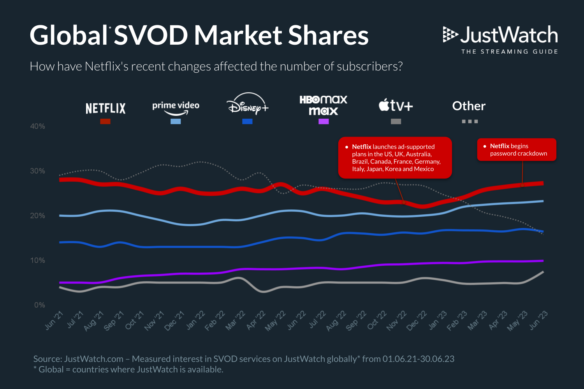
(16) VIDEO OF THE DAY. Ahsoka, a Star Wars Original series, begins streaming August 23 on Disney+.
[Thanks to Cat Eldridge, SF Concatenation’s Jonathan Cowie, Mike Kennedy, Joyce Scrivner, Moshe Feder, Rich Lynch, Andrew Porter, John King Tarpinian, Chris Barkley, and Michael Toman for some of these stories. Title credit belongs to File 770 contributing editor of the day Daniel Dern.]

